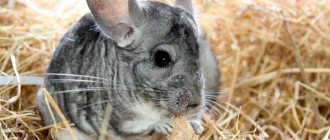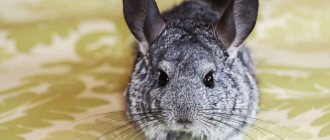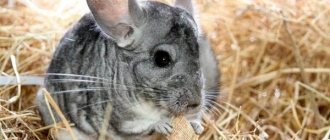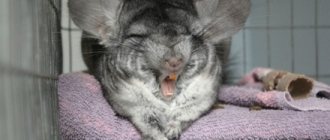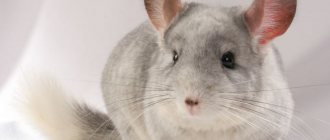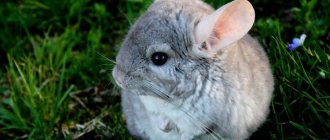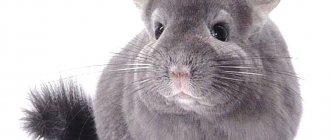Information / Behavior of chinchillas at home
The usual behavior of chinchillas at home is calm and friendly. The animal sleeps during the day, feeds and is active in the evening and at night. In a cage, a chinchilla spends most of its time on the top shelf. The animal sleeps sitting or in funny positions on its side. Chinchillas are active, at night they start a merry run around in the cage. The animals occasionally make sounds. You are probably familiar with the behavior of cats and dogs. It is very varied and informative, but chinchillas show emotions in their own way and show affection for humans. However, the conversation will not be about cuteness, but about the practical side of studying behavior. Let's try to understand by activity, behavior and emotions whether the chinchilla feels good or bad.
Historical facts about the origin of the chinchilla
Where exactly and from what animal chinchillas began their own origin is unknown. During excavations in the Cordillera, archaeologists discovered the ossified remains of the most ancient likenesses of animal species. Based on the type of genetic structure, they resembled the modern chinchilla. It should be noted that the prehistoric type of this animal was large in size.
In accordance with a rough estimate, the oldest animal, to which the found remains belong, lived about fifty years ago, therefore, the chronological information of these animals contains more than a thousand years.
The first literary mentions of the chinchilla family date back to the mid-sixteenth century. Fluffy lumps were mentioned in the work of a Spanish historian who sailed to South America with the conquistadors.
First meeting
Chinchillas are naturally very timid animals - they flinch at any sudden movement or unexpected sound. It is not surprising that upon arrival at a new place of residence, where everything is new for the pet, the fluffy will be extremely careful. Therefore, you should not force your attention on the animal. You need to give the chinchilla 10-12 days to adapt - let it get used to all family members, their voice, and daily routine.
All this time you should not touch, much less pick up, the chinchilla. After all, moving in itself is already a huge stress for the animal. Therefore, excessive interest on the part of household members will only delay the process of the pet getting used to the new place.
Outlining external data
Based on their appearance, chinchillas resemble large squirrels, and based on the way they move, they resemble bunnies. Fluffy animals have thick, thick and delicate fur, large dark eyes and large ears. It is with the help of the ears that chinchillas can reduce the overall temperature of the body, due to the fact that they have a dense capillary network.
The pet's body reaches 40 cm, and the tail - 15 cm. The forelimbs are shorter than the hind limbs, as a result of which their movement resembles hare jumps. Chinchillas have four toes on their hind legs and five on their front legs. With the help of their front paws, animals can carry out grasping movements.
A chinchilla has 20 teeth in its mouth; they grow throughout its entire life. Therefore, it is essential for an animal to be able to chew something.
Description
Pet lovers prefer the small chinchilla. An adult weighs up to 700 g. According to external data, the animal looks like a squirrel and a rabbit at the same time. On the face there are large black eyes with vertical pupils.
Chinchillas' ears are large, up to 6 cm in diameter, and have a rounded shape. They help get rid of excess heat. Acute hearing allows one to recognize the approach of a predator over long distances . Inside the auricle there are membranes that cover the ears while taking baths. This prevents sand from getting inside.
There are long whiskers on the cheeks from 8 to 10 cm. The rodent's head is large, located on a short neck. The stocky body measuring 20–35 cm is supported by four legs: short front and long hind legs. Due to the difference in size, a chinchilla is capable of jumping up 100 cm, or even higher.
Strong claws help chinchillas quickly climb vertical surfaces. The rounded tail is covered with coarse hair. Its length reaches 15 cm. It helps to maintain balance while moving or jumping.
The animal is covered with beautiful fur, the hairs of which fit tightly to each other. The most common color: white belly, ash back.
In their natural environment, chinchillas behave inconspicuously. Because of this, their character and way of life have not been studied enough. But it is known that the animals live in colonies of 100 or more individuals . One hole is shared by 2 to 5 chinchillas. The peak activity of rodents occurs at night, when they crawl out in search of food.
The average lifespan of a rodent in the wild is about 20 years. As a pet, with proper care, chinchillas can live up to 18 years.
How did chinchillas become domesticated?
Due to the fact that the number of furry animals has decreased significantly due to continuous fishing, a number of efforts have been made to domesticate this animal. Man did not have a single concept about animals. Not a single scientist could find out in what environment it should be, how proper feeding is carried out, therefore, all efforts and their reproduction in limited areas ended in failure.
In the 20s of the nineteenth century, the dream of a huge number of people on the planet about chinchilla farms became a reality thanks to Matthias Chapman. A mining engineer by qualification, Matias worked in Chilean mines and had close ties with the indigenous people inhabiting those lands.
One of them came to the man and offered to buy an unknown animal; the enthusiastic engineer bought the baby. He kept a new favorite under observation and thought about being able to deliver a number of similar animals to America and thoroughly begin breeding them. Having paid several Indians as guides and furball catchers, the man headed for the mountains. Having caught about 10 adult chinchillas, four of which turned out to be females, he returned from the USA. During the trip, one chinchilla gave birth to a litter of two rodents, but only one could survive.
It was this group of the chinchilla family that became the first animals that were able to bring a brood in a limited area, thereby the man laid the foundation for the domestication of individuals.
Fifty years later, there were several thousand chinchilla farms in America and neighboring Canada. Despite the fact that the animals were mainly bred only for their fur, quite a large number of breeders began to sell them as pets. One way or another, it was a profitable business; the price for one rodent could reach up to $200.
Currently, breeding is carried out throughout Europe, new unusual colors of fluffies are being acquired in connection with breeding work.
Why chinchillas
These funny pets have peculiarities and characteristics that are unique to them, which sets them apart from other rodents. The advantages of chinchillas include:
- pleasant appearance;
- no unpleasant odor;
- gentleness and trustfulness;
- relative ease of taming;
- absence of allergic reactions to fur and secretions of animals in people susceptible to allergies;
- self-sufficiency of pets: they rarely worry about loneliness, they are able to remain unattended for a couple of days if there is enough food and water in the cage;
- there is no need to vaccinate animals.
They rarely get sick if their owners follow the rules of hygiene when caring for them.
But there are some features that you should know about in advance when choosing this pet:
- intolerance to high levels of humidity and heat. If the air temperature exceeds 30 degrees, there is a risk of heat stroke, which sometimes leads to the death of the animal;
- the need for regular dust baths.
There is no need to wash the animal in water. Due to the increased hygroscopicity of a chinchilla's delicate fur, its cage must be equipped with a bathing suit - a container with dry sand, which will help the animal keep its fur clean and dry. The sand intended for this procedure is purchased at a pet store. Also, in order to prevent the appearance of fungal diseases on your pet’s skin, an antifungal drug must be added to the sand once every 30 days.
Do chinchillas have intelligence?
Experts confidently call the soft lump an intelligent and quick-witted creature. Quite a large number of chinchillas can manipulate the owner themselves, in order to beg for a treat or to take a walk outside the cage.
Cunning pets use something that the owner cannot resist. This is an offended little face, which he eagerly rushes to please with a delicious treat or get out of the cage. Understanding this hobby of the owner, the chinchilla can put on a deliberately unhappy and distressed expression on his face to achieve his own goals.
Differences in the behavior of females and males
It has been repeatedly noted that female chinchillas are much more active and larger than the male. Boys are lazy and smaller in size.
Males are not prone to display aggression, but girls can spray the offender with a stream of urine or bite.
Female chinchillas love increased attention to themselves and show a desire to communicate with their owner. Boys are able to remain alone for a long time, which does not bother them.
Regardless of gender, animals can be both tame and wild . It all depends on the nature of the pet, as well as the conditions of detention.
Characteristic traits of character and habits
Each chinchilla has its own character and habits; even animals from the same litter do not have the slightest unity. Just like humans, animals have 4 character types.
Choleric
This is a nimble, agile and active animal. During the daytime he dozes forward, however, his sleep is light, and he can wake up from the slightest rustle. During the period of activity, the pet, with inquisitive behavior, studies the objects around it and everything that interests it. Cholerics are quite timid, and, if frightened, the animal will rush around a limited area, demolishing everything that comes across on the road.
Sanguine
A chinchilla that has this type of character is also active and curious, but is less timid and can react calmly to loud sounds and rustles. The animal does not like to be in one position for a long period of time; it walks around the premises with interest with the permission of the owner.
Phlegmatic person
The phlegmatic chinchilla is a calm and balanced pet. Throughout the day she stays in her own home, replacing active games with sweet sleep. Even when awake, the phlegmatic animal moves measuredly, with some laziness.
Behavioral Signs of Stress
Chinchillas are susceptible to stress, which occurs under the influence of external or internal causes. Signs of stress in an animal include decreased appetite, decreased motor activity, avoidance of humans, and gnawing of fur. Learn more about stress factors and fur chewing >>> . Identify and eliminate stressors.
It happens that a wild chinchilla is not easy to handle; it will not bite or shoot urine, but will shed its fur. When you grab the animal, the fur will fall out at the point of contact with your hand. This is their protective natural instinct of “freeing themselves from the clutches of a predator.” Don't worry, the fur will grow back quickly. Try not to grab the chinchilla too harshly, especially not with a sudden movement from above.
Advice from veterinarians and experienced owners: how to toilet train a chinchilla
It is best to use commercially available scrap wood for your trash can. If a chinchilla does not want to go to the toilet and leaves its marks all over the cage, the owners need to train it.
To do this, every time an animal leaves its “mark” on the bottom of the cage, take the litter, wipe the affected area with it and put the sawdust back in the trash bin. The chinchilla will quickly learn by smell where to go to the toilet.
So the answer to the question of whether it is possible to tame a chinchilla in a trash bin is yes. But how often should you change the trash in your recycling bin? It is advisable to carry out this procedure every day. Only replace the dirty part of the trash can.
Does the animal have an unpleasant odor?
It is a common misconception that every pet has a foul odor. When you enter a house, you immediately feel what animal lives in it. However, the chinchilla refutes this stereotype. A healthy, furry animal is naturally odorless. The chinchilla is extremely clean and has no sweat glands.
It is rare for a pet to produce an odor without any abnormality. The cause of this anomaly is a dirty cell. Do not forget to promptly replace the bedding where the animal’s urine and excrement accumulates. Monitor the freshness of food and treats.
Stinky odors from a messy cage are also absorbed by your pet's fur.
To avoid this, it is important to clean and give her a sand bath in a timely manner.
Taming Recommendations
Summarizing the information presented, we can highlight several basic recommendations that will help make the taming process quick and comfortable for the animal:
- It is better to do taming in the evening, when the chinchilla is most active. During the day, the animal will be in a sleepy state, so it is unlikely to want to make contact.
- All stages of taming must be completed sequentially, without skipping a single step. It is allowed to move to a new level of communication only after mastering the previous one.
- Every action and every positive result needs to be reinforced with a treat. Food serves as a very powerful stimulus for rodents.
- In order for your pet to feel comfortable and protected, you will need to protect it from loud sounds, strangers, and other pets.
- If the chinchilla is in no hurry to establish communication, you should not break down, raise your voice, or even hit the animal. This will lead to a rollback of the achieved results.
- It is strictly forbidden to take a chinchilla by the scruff of the neck or cover it with your palm. In nature, rodents associate such actions with an attack. In such a situation, the chinchilla may fall into a stupor or begin to defend itself - blowing a stream of urine and biting, emitting a battle cry.
You also need to remember the safety rules. A chinchilla sitting in your arms can suddenly jump and run away. Therefore, during taming, it is better to be in a closed room without hard-to-reach (for humans) places.
In fact, taming a chinchilla is not as difficult as it seems at first glance. The main thing is not to force things and show the fluffy your sincere affection and care. Then the result will not be long in coming - even the most intractable pet will definitely reciprocate the love of the loving owner.
Will a chinchilla recognize its owner?
I think yes. Barbossa is not afraid of me and my boyfriend, but when guests came to us, he did not go into anyone’s arms.
From experience: When we come home, even if he was sitting in the house, he immediately runs up to the bars of the cage, grabs the bars with his paws and looks to see what we will give him.
It is believed that the chinchilla also recognizes the voice of the owner, so you need to talk to them. I often talk to Barbossa.
In the photo: chinchilla
Keeping a chinchilla at home: reviews from owners
A chinchilla is just a fluffy ball of incredibly soft fur. And one cannot call them too picky in matters of maintenance, but chinchillas, like all rodents, require certain conditions. Let's look at real reviews from owners who got this pet.
Veronica, 28 years old
I really wanted a chinchilla after I held it in my hands at the tactile zoo. She, of course, immediately cost more than a regular hamster, but desire took over. I'll start with something pleasant. Very beautiful, soft and interesting. You can really watch her for hours. Regarding nutrition - like an ordinary rodent, it eats corn, peas and other grains, hay. You can buy it at any pet store without any problems. She doesn't smell at all! This is a big plus! You don't need to bathe her, but I'll talk about sand later. As advice from me, you need to take a solid wheel. Otherwise, the chinchilla's paw may become sharp between the bars, and it may break! And all because the chinchilla runs by jumping.
This is my beautyAnd now I’m telling you about my mistakes! First, I took a small cage. Good thing, at a friend’s dacha I found a wooden shelving unit with a mesh door attached to it. She needs a lot of space to play, so even standard cages for chinchillas are best taken to the maximum size, with at least two floors. My second disappointment is that she doesn’t just walk in the evening, but late in the evening, after 10 and until the morning. In general, in my one-room apartment this noise was simply incredibly tiring. Another mistake I made was letting him go for a walk without a ball! I chewed through the internet cable. It’s good that the animal was not hurt, but the Internet was lost. There are still more disadvantages than advantages - she litters like an ordinary hamster. I thought it was a very smart and clean animal. Perhaps it’s not the chinchilla that’s the issue here, it’s just that, like any rodent, it goes to the toilet with peas and eats hay and grain! And you need to monitor the cage, if not every day, then definitely every 2 days. I vacuumed my apartment twice a day and it was still always dirty. I am mostly at work, so for me such cleaning before going out and upon arriving home took a lot of time.
As a result, after 4 months of torment we had to say goodbye - the owner was found quickly. In general, my verdict is this: a very beautiful and interesting animal. But this is a nocturnal rodent, albeit a furry one! Therefore, he needs a noise-isolated room so that he does not disturb his sleep during the day, and he does not disturb people at night.
Elizaveta, 32 years old
I'm very happy with the purchase - our whole family is crazy about it. It's been exactly a year since we got a new family member. I won’t tell you how cute and beautiful they are - you can already see from the photo. I will dispel the main myths and tell you what it is like to become the owner of a chinchilla. She is not picky, but needs special care. And the first thing is a lot of space. We have a private house, two floors. Therefore, her noise at night does not bother us, and she sleeps most of the day. She needs a big house and a lot of toys in it. We bought this display case for 5 thousand rubles. By the way, the purchase itself for the first time cost more than 13 thousand!
This is our house and foodAs you can see, we have a lot of food supplies - and that's not all! The chinchilla does not eat much, but requires a variety of food. If she is tired of food, she will throw it out through the cage and refuse it completely. But this is not the worst thing - monotony in food can also cause digestive problems. Their stomach is very receptive and they should be given absolutely clean things - I prepare many of them myself when I come to my parents in the village. The second point that chinchilla owners are often not ready for is cleaning. What do you expect when you buy a rodent? She is relatively very clean and does not smell like hamsters, for example. But you need to clean it at least 2-3 times a week or when it gets dirty. If you have a cage, place a tray underneath - this will significantly reduce the time. With a showcase, everything is much simpler. But I do every day:
- I give you something to drink and eat, it’s always fresh, even if there’s some left over
- I monitor the temperature and humidity
- I'm removing boluses. Speaking of them, on a chinchilla they should not smear; after a short period of time they become hard.
And I do this about 3 times a week:
- my feeder and water bowl
- I wipe the cage itself and all the toys and shelves
- I'm doing disinfection
- I put the bathing suit on
loves to sit in her arms
. She is very friendly, she makes contact quickly, but she is afraid of some guests, especially small children. She's scared of the noise! Our daughter is already an adult, so there were no problems with this. But if you have children who are under 10 or at least 8 years old, then do not torture the animal! She bathes in a very interesting way - this action still delights us all. Chinchillas can rearrange objects themselves - be prepared for this. They are very fast, smart and cunning, especially if they want to get out of the cage. You definitely can’t walk them on a leash; even around the house you only need to walk in a ball or under supervision! They have soft claws so they don't scratch or bite. For me, this is an ideal pet, which, like any type of animal, requires a little attention and care!
Keeping chinchillas is not particularly difficult, but relatively expensive. Although just such a pet will be an indicator of your high position, because not everyone can afford a chinchilla. And it’s not even a matter of finances, she’s a little demanding about the proper space for games. In addition, you should have your pet’s own room - after all, this is a nocturnal rodent that loves to make noise at night.
Is it possible to let a chinchilla out for a walk?
Chinchillas love to walk around the apartment.
This rodent is characterized by mobility, so it needs a large cage, in the presence of which walking around the apartment is not necessary. The cage should be equipped with a wheel, shelves, ladders, hammocks, tunnels - these devices will allow the harmonious development of the animal's muscles and skeleton.
The chinchilla cage can be equipped with all the necessary devices.
What attracts us to a chinchilla?
A funny, cute animal, which in recent years has become increasingly popular not for sewing luxurious fur coats, but for keeping at home. Moreover, comparing the chinchilla with other pets, it can be noted that it is not only not inferior to them, but even has its own advantages.
https://www.everystockphoto.com/
The chinchilla subtly senses changes in a person’s mood, sensitively reacting to the emotional mood of the owner. It is as if she mentally communicates with a person, reacting to his thoughts and sending him her message. In terms of energy and activity, few can compete with this small charming animal. Among chinchillas it is simply impossible to find a pair that is absolutely identical in their behavior and emotions - they are as individual as people and each individual has its own character.
https://www.everystockphoto.com/
They usually meet “by their clothes,” but these animals have an unusually beautiful coat – a velvety, pleasant-to-the-touch coat, each hair of which reaches two centimeters. This is what allows them to survive in the difficult climatic natural conditions of their homeland - the highlands of Peru and Chile. Chinchillas live in rock crevices at an altitude of 2-4 thousand meters, where wind and cold are common occurrences.
The absence of sweat and sebaceous glands also determines the absence of any unpleasant odor. There is also virtually no “aroma” from feces and urine, like from other domestic animals, including rodents. This greatly simplifies care - the bedding and litter in the toilet can be replaced every few days and makes keeping these animals even more enjoyable.
Chinchillas don't shed! However, if a chinchilla is frightened or stressed, it may shed hairs and whole clumps of fur - a kind of defensive reaction. In nature, it thus avoids the possibility of becoming dinner for a predator: the attacker is left with a tuft of fur in his teeth, and the animal itself is safely saved. So, if you don’t upset your pet, there won’t be any fur in the apartment. In addition, this rodent does not cause allergies even in the most “notorious” allergy sufferers.
https://www.everystockphoto.com/
The chinchilla is an extremely clean animal, but it cleans its fur not in water, but in special sand, in its homeland - in volcanic dust. Excess moisture is removed from the wool, the fur is cleaned. Another plus is that chinchillas do not have ectoparasites; they are simply not adapted to life in its dense undercoat.
A person is insured against chinchilla bites - she not only has beautiful “clothes”, but also remarkable mental abilities. Theoretically, with its sharp front incisors, it can seriously injure, but due to its high intelligence, the animal will first warn of possible troubles: it will lightly pinch or bite a little if a person or some animal behaves aggressively towards the chinchilla. If the warning doesn't work, a real bite may follow. In addition, without claws, the animal will not scratch anyone in the household. A chinchilla has nails that it chews on itself; the nails on its hind legs are slightly stronger than those on its delicate “hands.”
Under natural conditions, a rodent lives for about 35 years, but when kept at home, its life expectancy depends only on the owner, that is, what living and feeding conditions are created. Possessing good abilities, the chinchilla is easy to train and raise. But without pampering - they understand too quickly when they begin to be pampered and it is difficult, although not impossible, to re-educate later.
https://www.everystockphoto.com/
The animal is very “convenient” in terms of feeding: once a day in a small amount (1-2 tablespoons of food) is enough, they also drink a little water.
What to feed?
In the ZooIdea store you can buy food for chinchillas, specially prepared and balanced according to the needs of the animal. There is food for young chinchillas up to eight months and for adults. To replenish minerals and maintain mineral balance, use a mineral stone, it also grinds down your teeth. In addition to the main food, at ZooIdea you can buy treats and necessary vitamin and mineral complexes for chinchillas.
Pour a portion into the feeder, no more than one tablespoon, do not add until the bowl is empty. You should put food in once, preferably in the evening, before bed. The required norm can be determined by practice: if you’ve almost finished eating, put in less food the next day; the feeder is empty before the next portion - slightly increase the volume of food.
In addition to the main food, the menu may include rose hips, hawthorn, viburnum, and rowan, and they should be given dried. Your ward will definitely not refuse prunes, dried apricots, figs, raisins, dried apples and bananas. Vegetables you can feed are dried carrots, beets and onions. Potatoes are only suitable when baked in the oven, unsalted and without adding oil - like chips.
These products should be introduced into the diet from the age of eight months, once a week, just a little - the size of a bean. The fact is that up to 8 months the animal undergoes maturation, including the gastrointestinal tract. Fresh at this time it is allowed to give a small plastic apple or carrot. After the ripening period, all of the above can be given, but strictly limited, and it is necessary to change the treats: if they gave raisins today, then tomorrow there will be dried apricots or something else. This way you will avoid vitamin deficiency with diabetes and metabolic problems.
In the warmer months, the menu includes dandelion, plantain, young nettle, and tree and shrub shoots can be offered with buds and leaves. The chinchilla especially likes apple, willow, birch, linden, aspen, and hazel. Do not rush to offer greens right away “from the ground” - keep them in a shaded place for three to four hours. For the winter period, you can make preparations - drying the leaves and twigs of these plants. In the cold season, a chinchilla will happily eat a leaf or twig a day.
If you have a summer cottage, then you can give herbs and vegetables and berries to your pet. It’s better not to give market or store-bought ones - after all, you don’t know the growing and processing conditions, and the chinchilla’s body is very sensitive to all chemicals.
Prohibited!
Some foods should not be put on the chinchilla's table at all. Raw cabbage can cause bloating. Raw potatoes will become poison - the content of corned beef in them is categorically unacceptable to the animal's body. Exclude cheeses, dairy products, fish, chicken and sausages! The same goes for Brazil and pine nuts.
Also, not all herbs are suitable for your pet. Poison for them is fern, horsetail, St. John's wort, buttercup, crow's eye, datura and henbane.
The use of hay also has its own characteristics. Firstly, this should be the first mowing. Secondly, give a pinch no more than twice a week, as an addition to the main food. Good hay improves the functioning of the gastrointestinal tract, so it is advisable to prepare it yourself to avoid harmful plants. Hay cannot be used as the main feed - the quality of the fur coat drops catastrophically, the fur looks shabby and unkempt. And hay is not suitable for bedding for the same reason.
How to care?
Home arrangement
Before you go for a chinchilla, you need to take care of a home for living. You can buy a cage in the ZooIdea store; it should be spacious, with shelves, so that the animal can sit at a height and jump - this is close to their nature. The minimum dimensions of the cage are 0.6 x 0.5 x 0.6 m, in this case the animal feels good and is not cramped.
Be sure to consider setting up a sand bath. An aquarium or terrarium no smaller than a six-liter one will do - and the animal will be happy, and sand will not fly in all directions. If the bathhouse has a side entrance, then all the sand will soon end up in the cage. This way you won’t end up with enough sand, especially since the special kind is not that cheap; one kilogram is usually enough for six months. Sift the sand weekly. Regular sand needs to be replaced every six months (if less often, pathogenic microorganisms will multiply), and if the sand is anti-inflammatory, then it is changed every two months.
Place a house in the cage. In many cell models, manufacturers (Ferplast, Triol and others) initially provided for them. The little animal takes refuge in the house when strangers appear or while it gets used to its owner. A hammock or a hanging pipe can replace the house - suitable for sleeping and swinging.
It is better to make a hinged drinking bowl designed for rodents; 70-100 ml will be enough for a couple of days. It is necessary to wash the drinking bowl with a soda solution every time you change the water. A bowl of water should absolutely not be placed in the cage - the water will quickly become dirty and the fur will get wet, which is undesirable. Here you can place the feeder on the floor of the cage, but in such a way that your pet cannot knock it over (preferably made of ceramics), or you can make it hinged, like a drinking bowl.
Wood filler from conifers for rodents, without added minerals, or sawdust is used as bedding. Change the litter (and toilet) weekly. Every week you need to thoroughly rinse the cage using toilet detergent. After treatment, you MUST rinse both the cage and the trays with bars under running hot and then cold water (use a shower). Don't forget about processing the house and shelves.
The cage can be located both on the floor and on a shelf, bedside table - wherever it is convenient for you, but direct sunlight should be avoided. You can also place it near the heating radiator, but do not move it too close. Take care of the curtains - the animal, like all nearby shreds and rags, will pull them into the cage. Unlike many animals that require silence, chinchillas are more comfortable in company. There is no need for silence, and a working TV will not become a hindrance, on the contrary, it will be very useful. Even if the chinchilla is in a cage, she will not be so sad and lonely.
Features of adaptation to new conditions
Don't disturb the new resident for 3-4 days. The cage serves as a refuge for the chinchilla from which he can safely observe those around him. These rodents are sometimes called telepaths - they study and sense each family member so well and determine the line of further behavior. You should not pet or play with the animal in an excess of feelings on the first day - the reaction may be the opposite. Instead of quickly mastering a new place of residence, your ward will “withdraw into himself” for a long time and the period of adaptation will noticeably increase.
When the little animal gets used to it a little, you can open the cage and invite it to leave the cage, holding out your palms and saying: “Go out for a walk.” Do everything the same way every time - the chinchilla remembers your words and reacts to them accordingly. Do not make sudden movements and do not try to speed things up: everything must be done carefully, patiently, so that the pet begins to trust you.
Having left the cage for the first time, the rodent will begin to explore the room. Don't worry if he climbs into some inaccessible corner - don't try to immediately get the fugitive. After a while, he himself will appear to continue exploring the space. Try to arrange walks at set times, then he will return to the cage on his own, knowing that fresh food is waiting for him there (while he is on a walk, fill the feeder). When the exercise is over, call the animal: “Go eat and sleep.”
Chinchilla is toilet trained
Place a tray with wood filler. Don't expect the rodent to immediately run there - it will take some time and patience. Collect feces scattered on the floor of the cage into a tray in front of your pet. If he goes to the litter box on his own, be sure to praise him: “Good girl! Well done!" More positive emotions! Just a few times is enough for the animal to start visiting the toilet on its own - he really likes the attention and your approval. And it will become easier for you - you can change the toilet less often.
At first glance, it may seem that keeping a chinchilla is special, but each animal has its own requirements, it’s just that cats, dogs, and hamsters are more familiar to us. But if you decide to get a chinchilla, you will never regret your choice. And truly, a meeting “on clothes” will be a wonderful prologue to living together “on the mind”!
Expert advice on feeding
So, we learned how to train a chinchilla to the trash can and hands. But what kind of food should be offered to such an animal? Chinchillas are usually fed a specially purchased grain mixture.
Such products usually contain dried vegetables, fruits and pressed greens in addition to grain seeds. Sometimes manufacturers even add popcorn to such products.
From natural products, chinchillas get mainly fruits, vegetables and tree branches. In addition, chinchillas can be given carrot top, clover and dandelion. In winter, chinchillas can eat grass hay. Oats, barley, corn and wheat are the most suitable grains for chinchillas.
Rules and features of taming
When the chinchilla gets comfortable and behaves confidently, you can gradually begin taming. The rules for hand training young and adult animals are somewhat different.
Young chinchilla
The younger the chinchilla, the easier it is to tame. In these rodents, the formation of character ends by 7-8 months, so before this age they are more pliable and accommodating. To facilitate the process of taming a baby, you should use the following recommendations:
- Little chinchillas separated from their mother are very afraid of everything around them. Therefore, you should approach their cage carefully and slowly, and you need to talk to the baby in a quiet, gentle voice.
- To treat a young chinchilla during the taming process, only dry fruits and vegetables are allowed. Juicy foods can cause upset in the immature digestive system.
- From the first days you need to give your pet a nickname. So from the first days the animal will respond to the name and understand that the owner is addressing him specifically.
- You should not take home a chinchilla that is too small. Fluffies are breastfed for up to 2 months. Therefore, when buying such a baby, you will have to feed him with baby formula, and this is very troublesome.
However, if you still had to feed the chinchilla yourself, do not be upset. During the feeding process, the baby will get used to the new owner much faster. Therefore, the inconveniences caused by artificial feeding are fully compensated by the love and affection of the pet literally from the first days. Over time, such babies even begin to perceive the owner as a mother.
Adult chinchilla
Adult chinchillas are rarely kept as pets. But still, such cases sometimes occur. For example, after the removal of an animal from a cruel owner or when the owners move to another country. In any case, an adult pet experiences stress when it finds itself in a new family. After all, he is used to other living conditions or has been bullied, so he does not know what to expect from his new owners. To make the taming process as painless as possible, you must adhere to the following rules:
- For the first 2-3 weeks it is better not to contact the animal at all, just feed and clean the cage. Let the animal first get used to the new place.
- It is necessary to let your pet know about every approach to the cage so that he is not afraid. The signal can be given, for example, by clicking the tongue. Also, some owners use a clicker for these purposes - a small device that makes quiet clicking sounds when a button is pressed.
- If, during the process of taming, a frightened chinchilla bites the owner’s finger or palm, under no circumstances should you pull back your hand or scream. You will have to bravely endure the bite so as not to scare the animal even more.
- If the owner knows the old name of the animal, there is no need to change it. In the process of adapting to a new place, the chinchilla already experiences severe stress. If you start calling it by someone else's name, the pet will become even more confused.
- Since adult chinchillas take longer to get used to being handled, some impatient owners, in a fit of anger, begin to scold or hit the animal. Such behavior is strictly prohibited. This will not only not speed up the taming process, but, on the contrary, will only further alienate the pet from the new owner.
It is worth noting that in the process of hand training, both young and adult chinchillas go through the same stages. However, it takes approximately 2 times longer for an adult to complete each step. This is quite normal, there is no need to rush things, the pet will sooner or later be picked up.
If possible, it is necessary to find out what the adult animal was previously fed. Chinchillas react very sharply to a change in food, their condition deteriorates sharply, even to the point of death.
Where is it better to have a chinchilla in an apartment or in a house?
The home environment is an important factor to consider before adopting a chinchilla. There is no fundamental difference between a private house and an apartment. This type of pet does not need to be walked, so if you can allocate enough space for a cage or display, it will work well.
It is more important to choose a suitable case. Remember that the chinchilla is a nocturnal animal: it sleeps most of the time during the day, but becomes active at dusk. Placing the cage in your bedroom is a bad idea because it will prevent you from sleeping. It will be uncomfortable in the kitchen or living room due to the noise of household appliances and conversations.
Chinchillas are very sensitive to temperature changes. For example, overheating (above 22°C) can lead to heatstroke and death. Therefore, it is important to control the values both in summer (have air conditioning) and in winter (control the heating system).
Residents of apartments in multi-storey buildings should take this into account, since in many buildings housing and communal services are responsible for this, and balancing the numbers using personal equipment can be problematic. To avoid putting your pet in danger, make sure the environment is suitable before purchasing a chinchilla.
